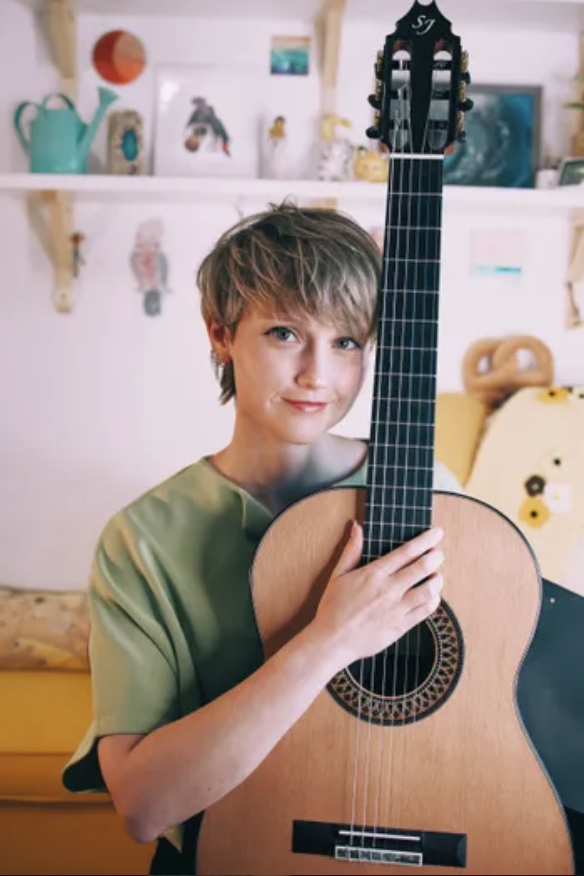by Jarrett Hoffman

In early 2021, Stephanie Jones was featured in the local music scene for the first time through a video — and a very popular one at that — recorded at her home in Munich and presented by the Cleveland Classical Guitar Society. Now, an event that also feels deserving of that word, she’ll finally be visiting Cleveland in person.
Perhaps great minds can gather and hash all this out. In the meantime, the more Stephanie Jones, the better — and on Sunday, September 17 at 3:00 pm, she will bring works by J.S. Bach, Richard Charlton, Ross Edwards, Jakob Schmidt, Quique Sinesi, Rostislav Golubov, Astor Piazzolla, and Antônio Carlos Jobim to the Maltz Performing Arts Center in a presentation by CCGS. See the full program here, and get tickets here.
I sat down with the Australian-born guitarist on Zoom and began by catching up on some life updates: since we last spoke, she has finished her master’s degree and Konzertexamen at the University of Music Franz Liszt Weimar, and is now teaching at the University of Augsburg — in addition to teaching through her Patreon, where her 25-member online studio is currently maxed out.
“It’s really nice to meet people from all over the world who are interested in the guitar and interested in learning something,” she said.
The latest news is that she’s setting out on a month-long American tour that begins in New York City, moves to Cleveland, then continues on to Minneapolis, Bozeman, Portland, Seattle, Los Angeles, Cupertino, San Francisco, and Austin.
“The program I’m touring with at the moment is a collection of my favorite pieces — and a few of them are what I wanted to play back when I first organized the tour in 2020. There are some of my ‘hit’ pieces that I really enjoy performing, and that I thought the audiences would appreciate — for example, Felicidade (Jobim) and the Piazzolla (Estaciones Porteñas).” A few of those favorites also appeared on the video from 2021, in a completely separate context in terms of program and, of course, setting. “It’s a different experience live and I thought it would be wonderful to have,” she said.
“And then I have a few completely different pieces that I haven’t been doing as long. A gorgeous, atmospheric piece from Australia called the Blackwattle Caprices — I haven’t released a video on that yet. I have a work by Jakob Schmidt, and this will be the U.S. debut for it. It’s a very fresh piece that’s also really gorgeous, with the different contrasts that are in there and lots of harmonics. And a Ukrainian piece by Rosaslob Halybov — that’s a wonderful, beautiful, melodic piece that I got up last year, I think. So a mixture of old and new.”
In our previous conversation, Jones had noted that Australian composers are often inspired by nature, which is certainly true for both Richard Charlton with his Black Cockatoo Flying Alone and Ross Edwards with the Blackwattle Caprices.
“Blackwattle is a bay in the Sydney Harbour,” Jones said. “It’s one of his favorite places, and that was the inspiration behind this piece. There are two caprices — the first is sort of a song, and then the second is a dance called ‘maninya’ — a name that he came up with himself. And it’s inspired by the sounds that insects make in the heat — this sort of cackle of these squeaks and whatnot. When you feel the heat in Australia and you hear these insects, it’s sort of like a dance — in a way it’s very rhythmical.”
Jones loves music that has a visual quality, and she noted that with Australian pieces, she likes to bring pictures to show to the audience — like a picture of a black cockatoo, or of Blackwattle Bay. I asked her, do those images stay in her brain while she performs? Do they play a part in learning the piece? Or are they just for the audience?
“Definitely the process of learning the pieces — interpretations inspired by these images,” she said. “I’m not necessarily thinking a bird when I play. It’s more about the story behind it. With a lot of my pieces, I sort of formulate a story while I’m playing. Then I have something that I feel I can resonate with and communicate with the audience. It just adds a bit more depth to the structure of the piece and how it’s presented. So I might be thinking of the bird flying by itself — what is it looking for, where is it going, does it find something, or does it not? And how that develops. That’s sort of how my interpretation is inspired in the moment.”
Speaking of birds, the black cockatoo really is quite something. “They’re very large birds,” Jones said. “There are lots of funny birds in Australia.” Perfect for bird photography — another interest of the guitarist’s.
“Birds tend to keep their distance, so you need a really long lens,” Jones said. “But when I go to Australia, it’s so much fun because the birds there are just super chill a lot of the time, so you can get up really close to them. And lots of them have beautiful colors and different patterns that are very interesting to look at.”
Published on ClevelandClassical.com September 14, 2023.
Click here for a printable copy of this article




